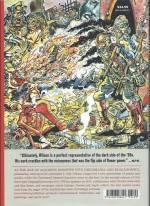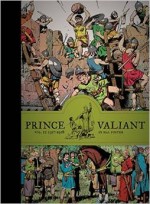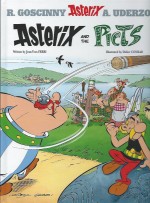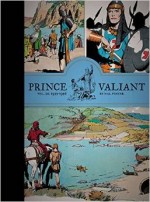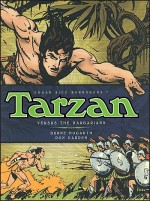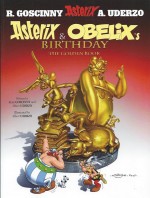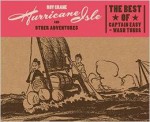
By Roy Crane, edited by Rick Norwood (Fantagraphics Books)
ISBN: 978-1-60699-809-0
Modern comics evolved from newspaper cartoons and comic strips, and these pictorial features were until relatively recently utterly ubiquitous and hugely popular with the public. They were also highly valued by publishers who used them as an irresistible sales weapon to guarantee and increase circulation and profits.
It’s virtually impossible for us to today to understand the overwhelming power of the comic strip in America (and the wider world) from the Great Depression to the end of World War II. With no television, broadcast radio far from universal and movie shows at best a weekly treat for most folk, household entertainment was mostly derived from the comic sections of daily and especially Sunday Newspapers. “The Funnies†were the most common recreation for millions who were well served by a fantastic variety and incredible quality.
From the very start humour was paramount; hence the terms “Funnies†and “Comicsâ€, and from these gag and stunt beginnings – a blend of silent movie slapstick, outrageous fantasy and vaudeville shows – came a thoroughly entertaining mutant hybrid: Roy Crane’s Wash Tubbs.
Washington Tubbs II was a comedic gag-a-day strip not much different from family favourite Harold Teen (by Crane’s friend and contemporary Carl Ed). Tubbs was a diminutive, ambitious and bumbling young store clerk when the feature debuted on April 21st 1924, but after only three months Crane re-evaluated his little enterprise and made a few changes which would reshape the entire art form.
Having Wash run away to the circus (Crane did much the same in the name of research) the artist gradually moved the strip into mock-heroics, then through a period of gently boisterous action romps to become a full-blown, light-hearted, rip-roaring adventure series. It was the first of its kind and dictated the form for decades thereafter. Crane then sealed its immortality with the introduction of prototype he-man and ancestral moody swashbuckler Captain Easy in the landmark episode for 6th May, 1929.
As the tales gradually became more exotic and thrill-packed, the globe-trotting little dynamo clearly needed a sidekick and sounding board. After a few bright and breezy types were tried and discarded, Crane decided on one who could believably handle the combat side of things, and thus in the middle of a European war, in the fairytale kingdom of Kandelabra, Tubbs liberated a mysterious fellow American from a cell and history was made.
Before long the mismatched pair were inseparable; tried-and-true travelling companions hunting treasure, fighting thugs and rescuing a bevy of startlingly comely damsels in distress…
The bluff, two-fisted, completely capable and utterly dependable, down-on-his-luck “Southern Gentleman†was something not seen before in comics: a taciturn, raw, square-jawed hunk played completely straight rather than the previously popular buffoon or music hall foil seen in such classic serials as Hairsbreadth Harry or Desperate Desmond.
Moreover Crane’s seductively simple blend of cartoon exuberance and design was a far more accessible and powerful medium for action story-telling than the somewhat static illustrative style favoured by artists like Hal Foster: just beginning to make waves on the new Tarzan Sunday page at this time.
Tubbs and Easy were as exotic and thrilling as the Ape Man but rattled along like the tempestuous Popeye, full of vim, vigour and vinegar, as attested to by a close look at the early work of the would-be cartoonists who followed the strip with avid intensity.
Floyd Gottfredson, Milton Caniff, Jack Kirby, Will Eisner and especially young Joe Shuster were eager fans taking notes and following suit…
After a couple of abortive attempts starring his little hero, Crane eventually bowed to the inevitable and created a full colour Sunday page dedicated solely to his increasingly popular hero-for-hire. Captain Easy debuted on 30th July 1933, in wild and woolly escapades set before his fateful meeting with Tubbs.
Both together and separately, reprinted exploits of these troubleshooters became staples of the earliest comic books (specifically The Funnies from October 1936 and The Comics, March 1937 onwards).
With an entire page and vibrant colours to play with, Crane’s imagination ran wild and his fabulous visual concoctions achieved a timeless immediacy that made each page a unified piece of sequential art. The effect of the pages can be seen in so many strips since, especially the works of such near-contemporaries as Hergé and giants in waiting like Charles Schulz. They have all been collected in the four-volume Roy Crane’s Captain Easy, Soldier of Fortune: The Complete Sunday Newspaper Strips.
Those pages were a clearly as much of a joy to create as to read. In fact, the cited reason for Crane surrendering the Sunday strip to his assistant Les Turner in 1937 was NEA Syndicate’s abruptly and arbitrarily demanding that all its strips be henceforward produced in a rigid panel-structure to facilitate them being cut up and re-pasted as local editors dictated. Crane just walked away, concentrating on the daily feature. In 1943 he quit NEA to create the wartime aviator strip Buz Sawyer, and Turner became the able custodian of the heroes’ fate.
Wash Tubbs ran until January 10th 1988.
Before all that however Wash was the affable and undisputed star of a never-ending parade of riotous daily black and white escapades and this superb hardback opens with two of them: part of a cherry-picked compilation of ten of the very best adventures of the bombastic buddies. Hopefully if this book is a hit it will lead to another complete reprinting such as the 18-volume series covering the entirety of the Wash Tubbs run – 1934-1943 and published by NBM from 1987-1992…
Before the non-stop nonsense begins author and pre-eminent comic strip historian Ron Goulart details all you need to know about the tales in ‘A History of Lickety Whop’ and editor Rick Norwood provides further background information in his copiously illustrated Introduction’ after which we’re all plunged into astounding adventure on ‘Hurricane Isle’ (which originally ran daily from February 23rd to June 6th 1928)…
At this time Wash and fellow inveterate fortune-hunter Gozy Gallup are gloating over securing an ancient map which once belonged to the dread pirate Edward Teach AKA Blackbeard!
As they research the infamous buccaneer and scrabble to find a ship to take them to their destination, they are unaware that aggrieved enemy Brick Bane – the Bandit King of Mexico – is hard on their trail and hungry for revenge. Stalking them as they journey from New Orleans to the Caribbean, he takes a nasty sea captain into his confidence and arranges for the sinister salt to hire out his ship to the treasure seekers. The skipper is unsavoury brute Bull Dawson: destined to become Tubbs’ – and later Easy’s – greatest and most implacable foe…
After travelling to the island with them Dawson, having already removed Bane, springs his trap and turns Wash and Gozy into enslaved labourers, digging with the crew to find the fabled horde. The lads soon rebel and escape into the jungle to search on their own, and also abortively attempt to steal Dawson’s ship.
The wily brute is always too much for them however and even after the boys finally locate the loot, the malicious mariner reappears to take it from them. The sadistic swine is preparing to maroon them when Bane shows up with a ship full of his Mexican bandits and a shooting war breaks out…
With bullets flying and bodies dropping, Wash and Gozy convince affable deckhand Samson to switch sides and the trio take off for civilisation with the treasure in the hold…
Money comes and goes pretty freely for these guys but by the time ‘Arabia’ (July 30th – December 12th 1928) begins they are still pretty flush and so opt for a luxurious Mediterranean cruise. Unfortunately Wash’s propensity for clumsy gaffes raises the ire of a very nasty sheik named Abdul Hoozit Hudson Bey and the affronted potentate swears vengeance when the ship docks in Tunis.
As if icing fate’s cake, when wandering through the bazaar Wash is glamoured by a pair of gorgeous eyes and inadvertently seals his doom by attempting to rescue a girl from a seraglio: Jada is not only a distressed damsel but Bey’s favourite wife…
Heeding the French authorities’ advice to leave town quickly, the lads take off on a camel caravan into the Sahara but have no idea they are heading into cunning Bey’s trap…
The fact that Jada is the favourite of the incensed chieftain saves them temporarily, but when the sheik finally finds a way to surreptitiously assassinate them, she and her devoted slave Bola dash into the deep desert to save them, and the quartet strike out for safety and freedom together.
That trek dumps them in the clutches of Bey’s great rival Abdullah Bumfellah and leads to a tribal shooting war. Happily Bola has been busy and found a Foreign Legion patrol to save the day.
And that’s when Jada drops her bombshell. She is actually a princess from a European principality, sold to Bey by her father’s Grand Vizier so that he could steal the throne. Now that she’s free again she must return to liberate her poor people. Despite having to get back to America, Wash won’t shut up about wishing he’d gone with her…
He soon gets the chance as ‘Kandelabra’ (April 11th – July 6th 1929) became the most significant sequence in the strip’s history; introducing Captain Easy in a riotous, rousing Ruritanian epic which we join after Wash reunites with Jada in the postage stamp kingdom she had been so cruelly abducted from.
Our little go-getter soon infiltrates the government and rises to the rank of admiral of the landlocked land but overplays his hand and is framed for stealing the army’s payroll. Delivered to a secret dungeon he (partially) escapes and finds a gruff fellow American who refuses to share his name but insists on being called “Easyâ€â€¦
Busting out his new pal, soon Wash and the stranger are caught in a bloody revolution when the aggrieved army mutinies. Before long the Vizier’s cronies are ousted, the vile villain accidentally orchestrates his own demise and the regally restored Jada declares the birth of the continent’s newest democracy…
In ‘Desert Island’ (February 6th – June 7th 1930) Bull Dawson returns to steal Tubbs’ entire fortune, flying off across America in a bid to escape with his ill-gotten gains. The robbery becomes a nationwide sensation and we join the action as Wash and Easy frantically pursue the fugitive. Tracking him to San Francisco they continue the chase when the malign mariner takes off in a schooner with our heroes as stowaways and, before long, prisoners…
The sadistic Bull lose faces after being thrashed in a no-holds barred fight with Easy which was merely subterfuge to allow the southern soldier of fortune to pick Dawson’s pocket and recover Wash’s easily portable $200,000 in cash. As the battered thug recuperates the ship is hit by a monster typhoon which apparently leaves our heroes the only survivors aboard the shattered shards of the schooner.
The wreck fetches up on a desolate Pacific atoll where the boys soon fall into the routine of latter-day Robinson Crusoes. The isolated idyll becomes complicated when they find the place is already home to a young woman who was the only survivor of an attack by roving headhunters from Borneo.
Mary Milton is brave, competent and beautiful and before long the lonely pals are fierce rivals for her affections…
The situation grows dangerously intense and only stabilises when the savages return, forcing the warring suitors to stand together or fall separately…
When the brutal battle ends the westerners are in possession of a sturdy war canoe and decide to risk their lives on an epic ocean odyssey to the nearest outpost of civilisation. It is only after the voyagers are far out to sea that Wash agonisingly recalls that he left his stash of dollars behind…
The next adventure (running from June 9th – October 1930) immediately follows on as the weary travellers reach French Indo-China and, thanks to a friendly soldier, escape far inland via a mighty river. After days of travel they reach the previously hidden kingdom of Cucumbria and quickly fall foul of the toad-worshipping emperor Igbay Umbay who takes one look at Mary and decides he must have her…
Being a coward who stole the throne from his brother, the grand poobah hasn’t the nerve to simply take her and orchestrates a succession of scurvy schemes to get rid of Wash and Easy but the boys are too smart and bold to fall for them. Infuriatingly rising in power and status, aided by young prince Hilo Casino – freshly returned from college in America – the Americans finally seem be out of the Umbay’s hair after they agree to lead his armies against the supernatural rebel leader known as ‘The Phantom King’…
Despite deep misgivings “General†Easy and his aide Washington Tubbs set out on a campaign that will ravage the hidden kingdom, unseat an emperor, cost thousands of lives and lose them the girl they both love…
A year later ‘Down on the Bayou’ (March 12th – July 25th 1931) found the world-weary wanderers nearing home again only to be arrested as they approach New Orleans in a stolen plane. They were fleeing a clever frame-up in infamous Costa Grande, but without proof could only evade their US Navy captors and flee into the swampy vastness of the Mississippi Delta…
Lost for days and starving, they are picked up by vivacious gangster’s moll Jean who recruits them into a gang of smugglers and rum-runners who inhabit a huge plantation somewhere between Pelican Island and Barataria dedicated to various criminal enterprises. Tubbs and Easy are soon comfortably settled in amidst the rogues and outcasts but everything changes when Jean’s brother returns from a smuggling trip. His name is Bull Dawson…
The pirate is prevented from killing our heroes by Jean and the huge Cajun in charge of the outlaw outpost, but Dawson takes it badly and with his gang of deadly bodyguards decides to take over the whole enterprise.
A couple of murders later Bull is big boss but also oddly friendly to his most despised enemies. Maybe it’s a ploy to put them off guard, but perhaps it has more to do with the gang of Chicago mobsters who have come down to put an end to the bootlegging mavericks cutting into their profits…
The troubles and bloodshed escalate exponentially and Jean drops her final bombshell: she’s a federal agent working with the Coast Guard to smash the budding criminal empire…
Once the dust settles she has one final surprise in store. In all the years of their friendship Wash could never get his taciturn pal to talk of his past or even reveal his real name. Now the government girl gives Mr. William Lee a message which sends him rushing across country to an old plantation home. Here the astounded Wash hears all about his pal’s shocking life, sordid scandals and abandoned wife …and then he learns the truth…
Soon the impediments and lies which blighted Easy’s life are all removed and the wanderer settles in to a well-deserved retirement with the girl he always loved but could never have. Tubbs moves on, quickly reuniting with old chum Gozy Gallup…
A few weeks later the ever-restless Wash is riding a tramp steamer headed for Europe, intent on paying Jada a visit in Kandelabra but, falling foul of rustic transportation systems, ends up in the similar but so different Principality of Sneezia…
Apart from pretty girls, the tiny kingdom has only one point of interest: the world’s dinkiest railway service. Run by aged expatriate American Calliope Simpson ‘The Transalpina Express’ (August 13th – November 21st 1931) links Sneezia to sister kingdom Belchia and is the most unique and beloved (by its intoxicated customers at least) service in the world.
Wash is especially keen to learn the business since being the engineer has made octogenarian Cal the most irresistible man in two countries, fighting off adorable young women with a stick…
The lad’s greatest dream comes true when Simpson finally elopes with one of his adoring devotees and Washington Tubbs become sole operator of the Express, but his joy at all the feminine attention soon sours when Belchia and Sneezia go to war and both sides want to use his train to move men and material into combat. Of course the dilemma can only end in disaster and before long our boy is running for his life again…
There’s a big jump to the next yarn which finds Wash and Easy reunited and stowing away on the wrong-est ship imaginable. Quickly caught, they are quite understandably assumed to be part of the contingent of prisoners bound for the final destination – ‘Devil’s Island’ (June 9th – August 30th 1932)…
No sooner are they mixed in with the hopeless prison population than the planning of their inevitable escape begins, but success only leads to greater peril as they and their criminal confederates take ship with a greedy captain subject to murderous bouts of paranoia and madness…
‘Whales’ (April 24th – August 30th 1933) is probably the most shocking – to modern sensibilities – of the perennial wanderers’ exploits as Wash and Easy are drugged in a Dutch cafe and dumped aboard one of the last sailing ships to work the whaling trade.
Elderly and nostalgic Captain Folly has been convinced by psychotic First Mate Mr. Slugg to compete one last time against the new-fangled factory whaling fleets, unknowingly crewing his creaking old ship with shanghaied strangers…
The grim minutiae of the ghastly profession is scrupulously detailed as our heroes seek some means of escape but with Slugg becoming increasingly unbalanced and eventually murdering Folly, bloody mutiny soon leads to the ship foundering and both factions – or at least the survivors of each – being marooned on the arctic Alaskan ice, where naturally our heroes find the only pretty girl in a thousand square miles…
This fabulous treasury of thrills concludes with one last battle against Bull Dawson after the incorrigible monster links up with gorgeous grifter Peggy Lake, who fleeces gullible Wash of his savings and disappears into the endless green wilderness of the swamps of ‘Okefenokee’ (June 13th – July 24th 1935).
The crime leads to a massive police manhunt through the mire before the boys personally track down the villains and deliver one more sound thrashing to the malodorous malcontent and his pretty patsy…
Rounding off this superb collection is a thorough ‘Captain Easy and Wash Tubbs Episode Guide’ by Rick Norwood as well as a glorious graphic Mexican travelogue feature by Crane in ‘An Afterword in Pictures’ as well as the informative biography section ‘About the Authors’.
If I’ve given the impression that this has all been grim and gritty turmoil and drama thus far, please forgive me: Crane was a superbly irrepressible gag-man and his boisterous, enchanting serials abound with breezy, light-hearted banter, hilarious situations and outright farce – a sure-fire formula modern cinema directors plunder to this day.
Easy was the Indiana Jones, Flynn (The Librarian) Carsen and Jack (Romancing the Stone) Cotton of his day – and, clearly blazing a trail for all of them – whilst Wash was akin to Danny Kaye or our own Norman Wisdom: brave, big-hearted, well-meaning, clay-footed, irrepressible and utterly indomitable everymen… just like all of us.
This superb monochrome landscape hardback (274 x 33 x 224 mm) is a wonderful means of discovering or rediscovering Crane’s rip-snorting, pulse-pounding, exotically racy adventure trailblazer.
This is comics storytelling of the very highest quality: unforgettable, spectacular and utterly irresistible. These tales rank alongside her best of Hergé, Tezuka and Kirby and led irrefutably to the creations of all of them. Now that you have the chance to experience the strips that inspired the giants of our art form, how can you possibly resist?
Hurricane Isle: The Best of Captain Easy and Wash Tubbs © 2015 Fantagraphics Books. All Wash Tubbs and Captain Easy Strips © 2015 United Features Syndicate, Inc. All other material © the respective copyright holders. All rights reserved.



